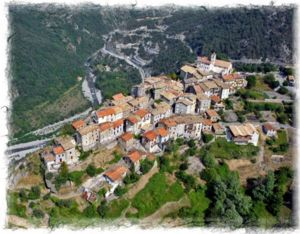With a backdrop of the Caire-Gros and Viroulet mountains, the Lauzette forest, and the Tinée river spreading its symphony in a distant echo, the village presents itself to the visitor, revealing its history to the more curious. The first house encountered on the road was the train station for the tramway going to Saint-Sauveur-sur-Tinée. The station of Marie, lost in the middle of nowhere, one must imagine the stagecoaches waiting for travelers.
It’s the junction of a narrow road leading to the village, with Marie situated at an altitude of 630 meters. The Vallon d’Ullion, a tributary of the Tinée itself a tributary of the Var, flows to the south of this town. The first mention of Marie dates back to 1066; the village was fortified by the Count of Provence.
The name Marie is that of a hermit who built a chapel dedicated to the Virgin. Miraculous healings were reported. The Abbey of San Dalmazzo di Pedona had a priory there under the patronage of Saint Ferréol. In the 14th century, the fief passed from the Rostaing of Valdeblore to the Grimaldi of Beuil. Marie obtained local freedoms in 1427. After the execution of Annibal Grimaldi in 1621, the lordship passed among several lords before finally being acquired in 1722 by the Lovera family, and Marie then became a marquisate.
The Church of Saint Pons dates from the 17th century. A priest was the driving force of this village: Father Jean-Baptiste Pierlas worked there from 1770 to 1816. In nearly half a century, he transformed his village, relocating the cemetery and the chapel of Saint Roch. Among other things, he is credited with a polychrome wooden Virgin sculpted in Genoa. This 400-kilogram statue was carried on men’s backs from Nice to Marie and installed on September 13, 1777, in the parish church.
At the top of the village stands the old castle and its medieval tower. The facades of the houses play with the sun and seem to change hue according to the path of the diurnal star. The feudal gate bears witness to Marie’s past as a sentinel village and defender of the County of Nice. While wandering through the narrow streets, one discovers the old communal facilities: a bread oven and mills. The inhabitants of Marie are called: the Marioles.
Thierry Jan


